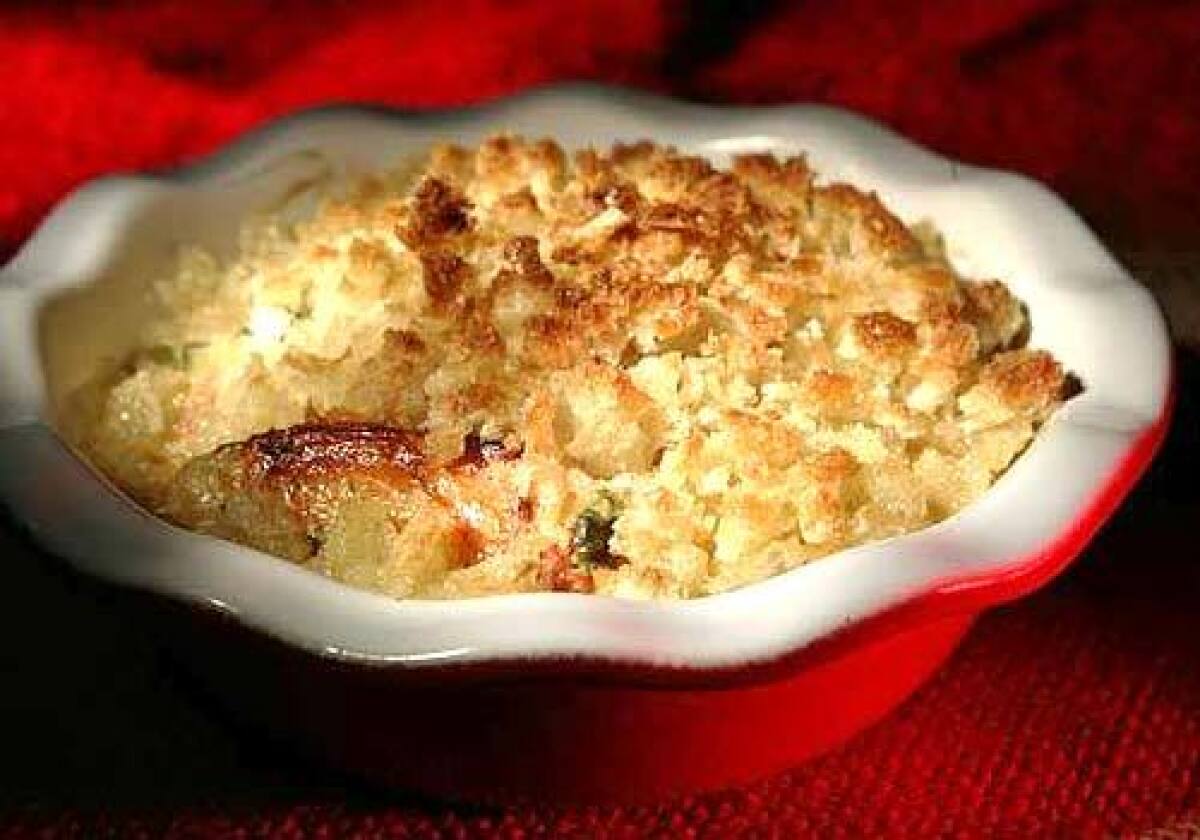The deviling made her do it!

IT was one of those farmers market moments. I was buying duck legs when the woman next to me asked how to cook them. I started rattling off my technique — brush them with mustard, dust them with bread crumbs — when she interrupted: “So you devil them.” I wanted to argue that it was a very particular méthode française, but then I had to concede: They’re deviled.
And that just reminded me what a simply superb technique deviling is.
It really does take not much more than mustard and bread crumbs to jazz up fish, meat, crab, even oysters and game hens. The piquant-crunchy coating does wonders.
But a deviled recipe doesn’t have to end in an oven. It can apply to anything that will benefit from serious seasoning.
Deviling has come to be most associated with summer, when boiled eggs get taken apart and put back together with mustard to go off on picnics, but it’s actually irresistible any time of year. Right about now, in fact, there’s no better way to use up some of those myriad jars of fancy mustard that inevitably stack up under a cook’s Christmas tree.
A dictionary will say deviling is just “preparing food with hot seasoning,” particularly cayenne or dry mustard, which is much hotter than the ballpark variety. The Oxford Companion to Food dates the term to the 18th century and says it was apparently linked to hell’s temperature, which makes sense.
As always, the French have a more lyrical name for the preparation — à la diable — and they apply it liberally: Larousse Gastronomique includes recipes for deviled beef, herring, oysters and tongue, all coated in mustard and crumbs and baked. But they also double the effect by serving a deviled sauce alongside.
*
The Beard way
DEVILING used to be a much bigger deal in American cooking. In the ‘60s and early ‘70s, James Beard busily wrote recipes for deviled ham, eggs, chicken, kidneys, crab and scallops. Most of them are just as tempting today. His deviled treatment of mushrooms, in fact, works even better with 21st century tweaks: shiitakes instead of button mushrooms, tamari instead of sherry vinegar. And while Beard said mushrooms should be served for breakfast, with bacon, toast and a broiled tomato, they are even better at dinner, ladled over grits.For all the range in deviled recipes, most rely on the same key components, used liberally. (The devil is not in the details.) Mustard is essential. Dijon, with its serious tanginess and creamy texture, is best because it contains very little besides mustard seeds and vinegar, so you get pure flavor, no bitterness.
Coarse-grain mustard is less pungent but has an intriguing nuttiness in both taste and texture. And dry mustard powder can be used to ramp up the heat in either of those. (Dissolving it in water to make a paste helps distribute it more smoothly.)
Worcestershire sauce is another staple of deviled foods, at least of the English and American variety. The flavor manages to be both ineffable and assertive, probably from the secret ingredient (fermented anchovies). Tabasco sauce, or any hot red pepper sauce, is also key. But you can also add extra heat with horseradish, either along with or instead of all the other hot elements.
For a more contemporary effect, try chipotle hot sauce instead of Tabasco, and Jamaican Busha Browne’s sauce instead of Worcestershire. Otherwise, the same condiments used for years work fine.
One ingredient, though, has changed for the better. Panko is far, far superior to the Italian-style, fine dried bread crumbs usually called for in deviled recipes.
For some deviled dishes, fresh bread crumbs are a smarter choice. In deviled Dungeness crab, the sauce is made from mayonnaise spiked with the usual hot seasonings and is rather rich. Panko soaks up the sauce and turns sodden, while fresh crumbs wick it, so that the crab is grease-free and the bread has the wonderful saucy flavors.
To get crumbs of any kind crunchy, you need to drizzle them with butter before baking — just enough to add crispiness without making them soggy.
*
Top with cheese
NOT all deviled recipes use bread crumbs. Sometimes cheese steps in. To make hot deviled eggs, just crack a large egg into a small ramekin of heavy cream heated with Worcestershire, mustard and hot sauce, top it with a coating of grated Gruyère or Fontina and bake it in a water bath at 350 degrees until the egg is cooked to your taste.Deviling is a particularly useful quick-change treatment for weeknight cooking. It’s better than just broiling for salmon fillets or steaks, chicken breasts, a gratin of scallops or oysters and, of course, duck legs. The combination of mustard and crumbs keeps the meat or fish juicy while adding irresistible crunch. With a little more time, you can make a meal in one pan with deviled game hens roasted on a bed of sautéed potatoes and onions with garlic and thyme.
The recipe is adapted from French chef Daniel Boulud, and of course it includes a diable sauce. He uses ketchup and A-1 sauce with the usual Dijon mustard, Tabasco and Worcestershire. Despite the American brands, it tastes perfectly French against the hearty hen and potatoes.
Game hens are rather tame and need that extra sauce. With more strongly flavored meat, particularly lamb, just the mustard and crumbs will do. A bistro will call it carré d’agneau à la moutarde. But it’s really just deviled.
**
Deviled Dungeness crab
Total time: 30 minutes
Servings: 4
2/3 cup mayonnaise
2 tablespoons chopped fresh cilantro
2 tablespoons Dijon mustard
2 tablespoons lime juice
1 tablespoon Worcestershire sauce, or to taste
1/2 teaspoon Tabasco sauce, or to taste
1/4 teaspoon cayenne, or to taste
4 green onions, green part only, finely chopped
6 piquillo or roasted red peppers, seeded and diced
1 pound picked over, cooked Dungeness crabmeat
Salt and freshly ground pepper
2 cups coarse, soft fresh bread crumbs
5 tablespoons melted butter
1. Heat the oven to 350 degrees. In a bowl, combine the mayonnaise, cilantro, mustard, lime juice, Worcestershire, Tabasco and cayenne. Mix well.
2. Stir in the green onions and piquillos. Add the crab and toss to mix well. Taste and adjust the seasoning, adding more of any flavoring if you like and salt and pepper to taste.
3. Divide the crab mixture among 4 small gratin dishes. Sprinkle evenly with the bread crumbs. Drizzle evenly with the melted butter. Bake 18 to 20 minutes, until the topping is crisp and lightly browned and the crab mixture is almost bubbly.
Each serving: 604 calories; 28 grams protein; 22 grams carbo- hydrates; 2 grams fiber; 47 grams fat; 12 grams saturated fat; 139 mg. cholesterol; 1,022 mg. sodium.
**Deviled Cornish hens with potatoes and diable sauce
Total time: About 1 hour
Servings: 2
Note: Adapted from “Café Boulud Cookbook” by Daniel Boulud and Dorie Greenspan
1 teaspoon dry mustard
7 tablespoons Dijon mustard, divided
2 game hens, about 1 1/4 to 1 1/2 pounds each
Salt and freshly ground black pepper
4 tablespoons olive oil, divided
1 clove garlic, finely chopped
1 medium onion, peeled and cut into 1/4 -inch dice
1 sprig thyme
2 medium Yukon gold potatoes, peeled, halved and sliced 1/2 -inch thick
2 tablespoons finely chopped Italian parsley
1/2 cup panko
2 tablespoons unsalted butter, melted
1 tablespoon coarse mustard
1 tablespoon ketchup
1 tablespoon A-1 steak sauce
1 teaspoon Worcestershire sauce
Tabasco sauce
1. Heat the oven to 400 degrees. Dissolve the dry mustard in one-half teaspoon water and blend into 6 tablespoons of the Dijon mustard. Set aside.
2. Working on one hen at a time, cut down either side of the backbone with kitchen shears or a sharp knife and remove the backbone. Lay the hen out, skin side up, on a work surface and press down hard on each side of the breastbone to butterfly the bird. Season on both sides with salt and pepper.
3. Heat 2 tablespoons oil in a large skillet over medium heat. Add the hens, skin side down, and cook 4 to 5 minutes on each side, until the birds take on some color (if the pan is too small, cook one at a time). Remove the hens to a platter and keep warm.
4. Wipe out the skillet and add the remaining oil. Add the garlic, onion, thyme and potatoes. Season well with salt and pepper. Cook, stirring often, until the vegetables are softened, about 8 minutes. Stir in the parsley.
5. Spread the potato mixture in a roasting pan or 9- by 13-inch glass baking dish just large enough to hold both hens in one layer. Arrange the birds on top, skin side up. Brush the skin of each evenly with the mustard mixture. Sprinkle evenly with the panko to coat. Drizzle with the melted butter.
6. Roast the hens 25 to 30 minutes, or until the juices run clear when a thigh is pricked.
7. As the hens cook, whisk the remaining 1 tablespoon Dijon mustard with the coarse mustard, ketchup, A-1 sauce, Worcestershire sauce and Tabasco to taste.
8. When the hens are cooked, run them briefly under the broiler to crisp the coating if necessary. Serve them with the sauce on the side.
Each serving: 1,083 calories; 57 grams protein; 65 grams carbo- hydrates; 6 grams fiber; 67 grams fat; 18 grams saturated fat; 180 mg. cholesterol; 1,924 mg. sodium.
**Grits with deviled shiitakes
Total time: 40 minutes
Servings: 4
1/2 cup yellow corn grits (not
instant)
1 pound shiitake mushrooms, cleaned and stemmed
4 tablespoons butter
2 large shallots, minced
2 cloves garlic, minced
1 teaspoon herbes de Provence
1/2 teaspoon coarse sea salt
1 tablespoon mushroom soy sauce or tamari
1 tablespoon Worcestershire sauce
1 tablespoon Dijon mustard
Tabasco sauce
3/4 cup very rich vegetable, veal or chicken stock
1 tablespoon chopped fresh chives
1. Cook the grits according to the package directions and set aside in a warm spot.
2. Thinly slice the shiitakes (if the caps are very large, cut them in half and then into slices). Melt the butter in a large deep skillet over medium-high heat. Add the shallots and garlic. Stir in the herbes de Provence, sprinkle in the salt and cook, stirring, 1 to 2 minutes. Stir in the shiitakes and cook, stirring constantly, until the mushrooms are tender and lightly browned, about 5 minutes.
3. Immediately add the soy sauce, stirring to loosen the browned bits on the bottom of the pan. Stir in the Worcestershire sauce, mustard and Tabasco to taste, mixing well. Add the stock and cook, stirring, just until the mushrooms are coated and a thin sauce forms.
4. Ladle the grits onto serving plates and spoon the shiitakes over them. Sprinkle with the chives.
Each serving: 254 calories; 7 grams protein; 28 grams carbohydrates; 2 grams fiber; 13 grams fat; 7 grams saturated fat; 31 mg. cholesterol; 598 mg. sodium.
More to Read
Sign up for our L.A. Times Plants newsletter
At the start of each month, get a roundup of upcoming plant-related activities and events in Southern California, along with links to tips and articles you may have missed.
You may occasionally receive promotional content from the Los Angeles Times.






